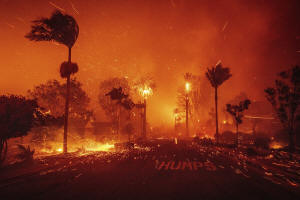Flawed emergency alert systems lagged when residents needed them most
during Los Angeles wildfires
 Send a link to a friend
Send a link to a friend
 [January 29, 2025]
By CHRISTOPHER L. KELLER, CLAUDIA LAUER, AMY TAXIN and
REBECCA BOONE [January 29, 2025]
By CHRISTOPHER L. KELLER, CLAUDIA LAUER, AMY TAXIN and
REBECCA BOONE
LOS ANGELES (AP) — When disaster strikes, government emergency alert
systems offer a simple promise: Residents will get information about
nearby dangers and instructions to help them stay safe.
As the deadly LA wildfires and other major emergencies have shown,
alerts rely on a complicated chain of communication between first
responders, government administrators, third-party companies and the
public.
Sometimes, the chain breaks.
After the wind-driven wildfires broke out in Southern California on Jan.
7, evacuation orders for some neighborhoods — including the part of
Altadena where the majority of deaths occurred — came long after houses
were reported on fire. On Tuesday, Los Angeles County officials approved
an outside review of how alerts functioned in the Eaton Fire and
Palisades Fire in response to residents’ demands. City officials
declined to answer AP's questions about a lag in some Palisades Fire
alerts, though Fire Capt. Branden Silverman said responding to a fire
and determining evacuation needs can take some time.
It’s an increasingly common issue: After-action reports and
investigations revealed issues with alert systems in other California
blazes: in the 2017 Tubbs Fire, which killed 22 people in Santa Rosa;
the 2018 Camp Fire, which killed 85 people in Paradise; the Woolsey
fire, which started the same day and killed three in Malibu; as well as
in Colorado's 2021 Marshall Fire, which destroyed more than 1,000 homes
outside Denver; and in Hawaii's 2023 Lahaina Fire, which decimated that
historic town and killed 102.

It could take months to know why some evacuation orders lagged in the
Los Angeles fires.
Several residents who lost homes in the Eaton Fire told The Associated
Press they received no notifications about their neighborhoods. For
others, the first warning was an urgent text message in the middle of
the night.
Susan Lee Streets, who signed up for the alert app Nixle, did not get
any alerts specific to her west Altadena neighborhood before she and her
family left of their own accord around 10 p.m. after losing power and
cell reception.
“If we had even been informed that houses and other structures were
burning down, we would have known better what was happening,” she said.
“We almost went to sleep that night with two kids and a dog and two cats
in the house.”
Only after 3 a.m. did an alert hit her phone. Destroyed along with the
house are the Christmas ornaments she saved for her children, and
countless other family keepsakes.
“We lost everything, everything,” Streets said, breaking into tears.
Tricia Wachtendorf, director of the Disaster Research Center at the
University of Delaware, said alerts have to be specific and clear.
Research has shown that for them to be effective, people have to hear,
understand, believe, personalize and confirm them before they react.
“Just because you send the message at 3 a.m. doesn’t mean someone is
hearing it,” Wachtendorf said.
The hours between midnight and 3:30 a.m. appear to have been
particularly challenging for first responders in Los Angeles County,
based on an AP review of scanner traffic recordings and data from
CalFire, the state's chief fire agency; the Federal Emergency Management
Agency, or FEMA; and the Watch Duty app.
Resources were stretched thin, and hurricane-force winds had grounded
air support, limiting authorities' ability to get a top-down perspective
on the flames.
Calls reporting burning homes were flooding in as embers blew onto roofs
and yards. During one half-hour period, 17 new addresses were relayed to
firefighters, even as some crews ran low on fuel.
By 12:07 a.m., CalFire records show, dozens of neighborhoods had been
ordered to evacuate because of the Eaton Fire, all of them east of
Altadena's North Lake Avenue. None of the neighborhoods to the west —
where all of the 17 confirmed fatalities occurred, as first reported by
the Los Angeles Times — had received evacuation warnings or orders,
despite house fires being reported there more than an hour earlier.
[to top of second column]
|

The Palisades Fire ravages a neighborhood amid high winds in the
Pacific Palisades neighborhood of Los Angeles, Tuesday, Jan. 7,
2025. (AP Photo/Ethan Swope, File)

Over the next three hours, fire crews would go from begging for
resources on the eastern flank of the blaze to radioing the command
center to make sure it knew the fire was spreading west along the
foothills near Sunset Ridge.
Just before 3:30 a.m., evacuation orders expanded significantly,
with residents in 12 areas of Altadena and elsewhere told to “leave
now.”
Jodi and Jeff Moreno first heard about the fire from a neighborhood
app. But the first official warning only came around 2:30 a.m., when
authorities yelled through a bullhorn to evacuate. The couple
grabbed their three daughters, their dog and some important papers,
and fled.
There were no text alerts until after they were gone.
“On the neighborhood apps, some people were going, some people were
staying. It was a wide variety of responses. We were navigating it
on our own,” Jodi Moreno said. “It’s hard for us to gauge where
exactly is that fire, where are the embers blowing. ... Those are
things I would rely on people who are monitoring it” for
information.
Desperate for more information, both the Morenos and Streets
downloaded the Watch Duty app, which maps evacuation zones and
consolidates information from multiple sources into a single stream.
Launched in 2021 and today covering 22 states, it became a lifeline
for them.
“The ideal system for warning people is informing them, right?” said
Nick Russell, vice president for operations at Watch Duty.
“There’s certainly diligence necessary in the execution of official
evacuation warning and orders or shelter in place, whatever the
condition might be,” he said. "But telling people why that
discussion is taking place between law enforcement and fire is
important. And that’s what we’re doing.”
The process of issuing evacuation notices starts with firefighters
or other personnel on the ground recommending action, Russell said.
It then moves up the chain of command to sheriffs, who ultimately
put out any order.
During major emergencies that communication can be hampered by
issues such as limited radio connectivity, wind noise or other
technical problems. Incident command stations may have trouble
synthesizing the large amounts of information they are getting from
different agencies, something that is critical for understanding the
scope of an emergency like a fire.

In Los Angeles County, residents who sign up for emergency
notifications through the AlertLACounty website are then directed to
a list of 57 links to other specific neighborhood or city alert
system signups, as well as a general one covering 19 other cities.
The city of Los Angeles and the Sheriff's Department also have alert
systems.
It is not clear how the overlapping systems, which use different
software programs, work together, or whether officials coordinate.
A 2024 Hazard Mitigation plan directed the city's Emergency
Management Department to assess gaps in alert and warning systems in
areas with poor cellphone connectivity and then implement a solution
to ensure alerts reach people. But that goal was given a “medium”
priority level and a long-term timeline, with completion expected
sometime in the next 10 years.
Meanwhile the county's Hazard Mitigation Plan, last updated in 2020,
did not include a focus on emergency alerts or public notifications.
Instead its high-priority goals had to do with educating people
about wind's impact on wildfire risk and with community wildfire
protection.
Officials at the County’s Coordinated Joint Information Center
declined to comment other than to say that an independent review of
evacuations and emergency notifications is planned and the Office of
Emergency Management, County Fire Department and Sheriff’s
Department plan to fully engage with it.
All contents © copyright 2025 Associated Press. All rights reserved |